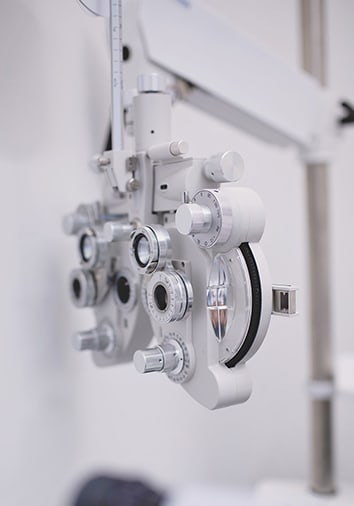Both astigmatism and keratoconus affect the cornea and impact vision. They may seem similar at first, presenting similar vision issues like blurred vision, light sensitivity, and difficulty seeing at night. However, astigmatism is a common refractive error that can more easily be corrected with glasses, whereas keratoconus is a progressive eye condition requiring specialized treatment to help manage.
What Is Astigmatism?
Astigmatism is a common refractive error caused by an irregularly shaped cornea or lens. Instead of being round, the cornea or lens is more oval-shaped, like a football. This irregular shape prevents light from focusing properly on the retina, causing blurry or distorted vision at various distances.
Symptoms of Astigmatism
Common symptoms of astigmatism include:
- Blurry or distorted vision
- Eye strain or discomfort
- Poor night vision
What Causes Astigmatism?
When your cornea or the lens is more oval than round, light can’t properly focus on your retina. This irregularity can be caused by certain factors, including:
- Genetics
- Eyelid pressure on the cornea
- Eye injuries or eye surgery
Most people have some level of astigmatism. More severe astigmatism can lead to distorted vision, eye strain, and headaches unless corrected with glasses or contact lenses.
Treatment Options for Astigmatism
Treatment typically includes:
- Eyeglasses or contact lenses: These are the most common and effective ways to correct vision caused by astigmatism.
- Orthokeratology (Ortho-K): These are specialized contact lenses worn overnight to temporarily reshape the cornea.
- Corneal refractive surgery: For suitable adults, procedures like LASIK provide a more permanent solution to reshape the cornea and help correct astigmatism.

What Is Keratoconus?
Keratoconus is a rare, progressive eye condition that causes the cornea to thin and bulge into a cone shape. This causes a large amount of astigmatism, leading to blurred, poor vision that cannot be corrected easily with glasses.
Symptoms of Keratoconus
In the early stages, it may be difficult to tell keratoconus and astigmatism apart. They share many symptoms, but keratoconus may also result in:
- More frequent prescription changes for glasses or contact lenses
- Seeing halos or starbursts around lights
- Not being able to fit contact lenses properly
- Corneal swelling or scarring
What Causes Keratoconus?
The exact cause of keratoconus isn’t fully understood. However, a combination of genetic and environmental factors, such as excessive eye rubbing or a family history of the condition, may play a role.
Keratoconus is often associated with eye allergies and excessive eye rubbing.
How Is Keratoconus Diagnosed?
A comprehensive eye exam can detect many different eye concerns like keratoconus. Your optometrist uses several diagnostic tools to evaluate your eye health.
To assess and measure your corneal shape and thickness, your optometrist may conduct certain tests and techniques, including:
- Corneal topography to create a detailed map of the cornea’s surface
- Pachymetry to measure the thickness of the cornea
Treatment Options for Keratoconus
Since keratoconus is progressive, treatment will depend on the stage of the condition.
At earlier stages, eyeglasses and soft contact lenses can help correct vision. As the condition progresses, regular contact lenses become less effective. Depending on the shape of your cornea, some contact lenses may no longer properly fit over the eye.
What Are Scleral Lenses?
Scleral lenses help address various eye issues, including keratoconus. These lenses are especially valuable for people with abnormally shaped corneas. They rest on the sclera and vault over the cornea, leaving a gap between the lens and the cornea. This gap is filled with a saline solution to provide comfort while correcting vision.
Why Early Diagnosis Matters
Identifying and addressing keratoconus or astigmatism early can improve your treatment outcomes and help maintain your quality of life.
Left untreated, keratoconus can lead to severe vision impairment, sometimes requiring more invasive procedures like corneal transplants. Similarly, uncorrected astigmatism can cause headaches and eye strain, impacting your daily activities.
Regular eye exams can help monitor your eyes and vision to safeguard your ocular health. Many conditions, like keratoconus, are difficult to detect without a comprehensive exam. Once evaluated, your optometrist can help determine a personalized treatment plan.
Even common refractive errors like astigmatism often require a professional assessment to correct. Eye exams help keep your prescriptions up-to-date and your eyes healthy.
How Daniel Island Eye Care Supports Your Eye Health
At Daniel Island Eye Care, we’re committed to educating and supporting patients dealing with various eye conditions. If you’re experiencing vision problems, or if you suspect you have astigmatism or keratoconus, our team is here to guide you toward the best solutions for your unique needs.
Contact our team today to book your appointment and stay on top of your eye health. Taking proactive steps can help you maintain clear, comfortable vision.
























